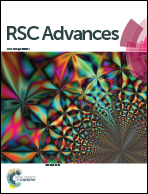Synthesis and antibacterial activities of graphene decorated with stannous dioxide†
Abstract
We report the synthesis and antibacterial activity of water dispersible stannous dioxide (SnO2) modified with graphene (G) nanosheets. Nanomaterials of G and SnO2@G were prepared and then characterized by transmission electron microscopy (TEM), ultraviolet (UV) spectroscopy, Fourier transform infrared (FTIR) spectroscopy, Raman and fluorescence spectroscopy. The antibacterial activities were investigated using Pseudomonas aeruginosa and Staphylococcus aureus as model strains of Gram negative and Gram positive bacteria, respectively. The antibacterial activities were evaluated using optical density (OD600) and plate counting methods. The results indicated that SnO2@G displayed a higher cytotoxicity than G by 1–3 fold. The G-based nanomaterials inhibited the growth of P. aeruginosa more effectively than for S. aureus. SnO2 increased the cytotoxicity of G against Gram negative bacteria by 3.6 times due to the synergic effect. The interactions between the prepared nanomaterials and bacteria cells were evaluated using TEM, fluorescence spectroscopy and matrix assisted laser desorption/ionization mass spectrometry (MALDI-MS). The data revealed that there were many forces facilitating the SnO2@G nanosheets to adhere to bacteria cells, which block the cells from taking nutrients, and result in cell death. We expect that this novel G-based composite can be effectively applied in the future for environmental and clinical applications.


 Please wait while we load your content...
Please wait while we load your content...